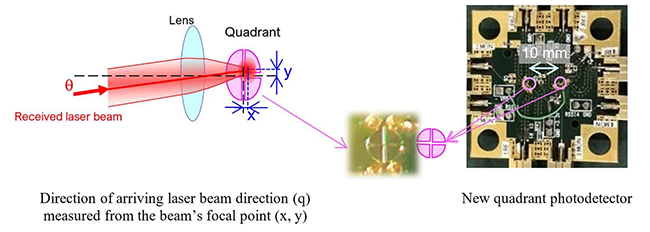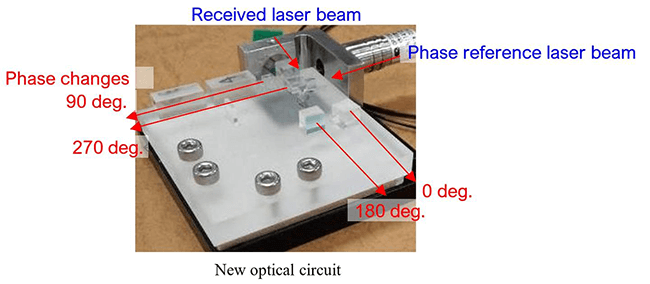Recently, Mitsubishi announced the world's first laser receiver designed for Earth-based satellite communications. What challenges does conventional satellite communications present, what has Mitsubishi developed, and could laser communications find applications on Earth?
What challenges does traditional satellite communication technology bring?
Over the past 50 years, satellite communications have played a key role in providing telecommunication services, activity monitoring, environmental tracking and weather observation. But while satellite technology has advanced a long way thanks to modern developments, radio waves remain the only means of communication.
Now, there have been major improvements in the field using a variety of frequencies and establishing dedicated frequency bands to reduce interference, and improvements in electronics allow for higher data rates, but the use of radio wave energy has not changed. This is primarily because radio waves are easy to transmit and receive, can easily penetrate the Earth's atmosphere, and their divergence allows for more general targeting requirements (i.e. the transceiver needs to be pointed in the general direction of the target within a few miles rather than a few centimeters).
But radio waves are not without their flaws, and modern satellite systems continue to be plagued by radio wave degradation. First, their relatively low frequency (compared to visible light lasers) reduces their bandwidth, making it challenging to form high-speed data links. This is particularly problematic for imaging satellites that need to report high-resolution data in real time.
The second challenge with radio waves is their divergence. While wider radio beams can make it easier to hit a target, they also run the risk of interfering with other satellites, and thus require their own unique frequency band. This also has the added effect of reducing bandwidth and limiting the total number of satellites in any given area.
The third challenge is that radio communication systems often require large antennas and dishes. Devices that only receive (such as GPS modules) do not need us to separate, but anything that needs to send data back to the satellite will need a dish. Therefore, radio communication systems can become bulky and difficult to integrate into smaller devices.
Mitsubishi announces world's first satellite laser communications terminal
Mitsubishi recognizes the challenges faced by traditional radio communication systems used in satellites and recently announced the development of the world's first laser communication terminal. Instead of satellites using radio waves, their new system uses infrared light in the 1.5μm band, which is formed into a laser beam. The width of the new beam is 1/1000 smaller than current radio systems, which means it is much less likely to interfere with nearby systems that are not directly observing the laser beam.
However, using laser beams for long-range communications presents some significant challenges, the most obvious being intensity degradation. A laser beam showing through the Earth's atmosphere quickly loses intensity, making it difficult for a receiver to detect the incoming beam. Another serious disadvantage of laser beams is that their narrow divergence requires them to be pointed directly at the receiving satellite. Combine this fact with the rapidly moving nature of satellites relative to the ground, and the result is a system that needs to track satellites while keeping a small, thin laser beam pointed at a receiver hundreds of miles away while achieving on-target accuracy of less than a meter.
However, Mitsubishi researchers have demonstrated a terminal receiver that can do just that. The receiver is able to determine two main factors from an incoming light beam: its phase shift and its direction. The incoming direction of the beam is determined by using a lens and a quadrant sensor, which consists of four main sensing elements. This allows the system to precisely identify the position of the incoming light beam, thereby adjusting its angle and position to best receive the incoming signal.

The additional use of multiple beam splitters and reference beams also allows the device to detect four phase changes of 0 ̊, 90 ̊, 180 ̊ and 270 ̊. The significance of detecting phase shifts will enable data to be transmitted using phase shifts rather than just intensity control. While intensity control is the simplest form of data communication, it can easily interfere with changes in ambient light and atmosphere, but phase changes are almost impossible to interfere with.
Overall, the new device is housed in a 10-centimeter box, which is not only considered the world’s first satellite optical laser solution, but also one of the smallest and lightest.

Can laser communications become practical for ground-based communications?
While researchers still have many hurdles to overcome when using lasers on satellites, using laser communications for terrestrial applications is also surprising.
One application that could greatly benefit from laser communications is military operations. Modern radio systems use encryption methods to ensure data integrity, but any security flaws could allow enemy forces to collect critical intelligence. In addition, enemy forces may also deploy radio jamming devices that deny the use of radio waves, and these systems are very difficult to counter.
But using a laser beam would provide military command posts with direct communications that are protected from hacking and jamming. Using a beam directly would mean that anyone who wants to hack would have to block the beam, not an easy feat considering that blocking the beam would be detected by both sides.
Furthermore, the beams cannot be interfered with like radio waves, and any attacker wishing to disable the link would need to point an intense laser beam at the receiver, which would reveal the enemy's location, or stand between the beams, which would still reveal the enemy's location.
Laser beams could also potentially be used to connect cellular towers located in remote areas where fiber optic links are difficult to install. The entire array of beams could be set up nearby without interfering with each other, and adding each beam would further increase the bandwidth of the data link. Finally, using laser beams eliminates the interference effects between cellular networks, allowing for long-distance communications without installing extensive infrastructure.
Laser communications offer exciting opportunities for both satellite and terrestrial communications. There are still many challenges to be solved, but the ability to create non-interfering, high-bandwidth communications channels could open up entirely new applications.
Previous article:VIAVI presents new fiber testing solutions at OFC, empowering fiber testing and certification with innovative technologies
Next article:VIAVI presents at the 22nd China Optical Network Symposium, charting the future of optical networks
- Popular Resources
- Popular amplifiers
- Keysight Technologies FieldFox handheld analyzer with VDI spread spectrum module to achieve millimeter wave analysis function
- Qualcomm launches its first RISC-V architecture programmable connectivity module QCC74xM, supporting Wi-Fi 6 and other protocols
- Microchip Launches Broadest Portfolio of IGBT 7 Power Devices Designed for Sustainable Development, E-Mobility and Data Center Applications
- Infineon Technologies Launches New High-Performance Microcontroller AURIX™ TC4Dx
- Rambus Announces Industry’s First HBM4 Controller IP to Accelerate Next-Generation AI Workloads
- NXP FRDM platform promotes wireless connectivity
- WPG Group launches Wi-Fi 7 home gateway solution based on Qualcomm products
- Exclusive interview with Silicon Labs: In-depth discussion on the future development trend of Bluetooth 6.0
- Works With Online Developer Conference is about to start, experience the essence of global activities online
- LED chemical incompatibility test to see which chemicals LEDs can be used with
- Application of ARM9 hardware coprocessor on WinCE embedded motherboard
- What are the key points for selecting rotor flowmeter?
- LM317 high power charger circuit
- A brief analysis of Embest's application and development of embedded medical devices
- Single-phase RC protection circuit
- stm32 PVD programmable voltage monitor
- Introduction and measurement of edge trigger and level trigger of 51 single chip microcomputer
- Improved design of Linux system software shell protection technology
- What to do if the ABB robot protection device stops
- Detailed explanation of intelligent car body perception system
- How to solve the problem that the servo drive is not enabled
- Why does the servo drive not power on?
- What point should I connect to when the servo is turned on?
- How to turn on the internal enable of Panasonic servo drive?
- What is the rigidity setting of Panasonic servo drive?
- How to change the inertia ratio of Panasonic servo drive
- What is the inertia ratio of the servo motor?
- Is it better for the motor to have a large or small moment of inertia?
- What is the difference between low inertia and high inertia of servo motors?
- Understanding 5G modulation in one article [illustrated and easy to understand]
- Types and principles of filters
- How to implement a home wireless network based on Zigbee technology
- [Environmental Expert’s Smart Watch] Part 15: Add ambient light, and all attributes are complete!
- How to Make DSP Digital Oscillator Generate Phase-Shifted Sine Wave
- About the problem of modifying the frequency offset of CC2650 chip
- MaixSense R329 development board Armbian system experience
- Zigbee packet capture analysis - Introduction
- About STM32 sampling pressure sensor value
- msp430g2101 MCU, flash chip using FET-Pro430 software, program can erase, but read and write both fail

 NJM741V
NJM741V












 京公网安备 11010802033920号
京公网安备 11010802033920号